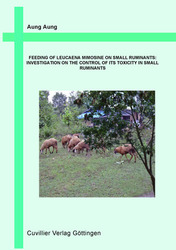| Areas | |
|---|---|
| Serie de libros (96) |
1378
|
| Nachhaltigkeit |
3
|
| Gesundheitswesen |
1
|
| Letra |
2362
|
| Ciencias Naturales |
5406
|
| Matemática | 229 |
| Informática | 319 |
| Física | 980 |
| Química | 1363 |
| Geociencias | 131 |
| Medicina humana | 243 |
| Estomatología | 10 |
| Veterinaria | 108 |
| Farmacia | 147 |
| Biología | 835 |
| Bioquímica, biología molecular, tecnología genética | 121 |
| Biofísica | 25 |
| Nutrición | 45 |
| Agricultura | 1004 |
| Silvicultura | 201 |
| Horticultura | 20 |
| Ecología y conservación de la tierra | 148 |
| Ciencias Ingeniería |
1790
|
| General |
97
|
|
Leitlinien Unfallchirurgie
5. Auflage bestellen |
|
Erweiterte Suche
Feeding of Leucaena Mimosine on Small Ruminats (Tienda española)
Investigation on the Control of its Toxicity in small Ruminants
Aung Aung (Autor)Previo
Indice, Datei (17 KB)
Lectura de prueba, Datei (220 KB)
Rumen juice was treated with gradually increasing amount of mimosine to develop a bacterium that degrades mimosine by using IBT-Göttinger Bioreactor. At the beginning, the amount of mimosine was 25 mg/d and 25 mg mimosine was increased every two days. The fermentation period was 16 d and final amount of mimosine was 200 mg/d. Samples treated with 200 mg mimosine /d showed mimosine degradation within 3 -7 d. After fermentation for selection, mimosine degrading ruminal bacterium was isolated and identified using bacterial staining, PCR amplification and DNA sequencing. According to identification, it was known as one of Klebsiella pneumonae spp. Another mimosine degrading ruminal bacteria, Synergestii jonesii was provided from USDA to compare mimosine degradability with new isolate. These bacteria were multiplied with IBT-Göttinger Bioreactor and preserved for storage to use in farm by freeze-drying and incorporation of bacteria in alginate beads.
The bacteria preserved were used for field experiment with digestion trial in Myanmar sheep. The experiment included 10 groups and 3 animals in each group. Group I was control group without leucaena feed and group II was control group fed toxic level of luecaena feed. The animals from group III-X were inoculated with mimosine degrading bacteria to observe and compare mimosine degradability of different types of preservation, dosage (once and 14 days continuous inoculation) inoculation and strains of mimosine degrading bacteria. The experimental period consisted of 7 d for preliminary experiment, 14 d for feeding trial and 5 consecutive days for collection of faecal and urine samples. All diets were adjusted to be isonitrogenous at the feeding level. Dietary treatments were weekly adjusted by the supplements at the level of crude protein not less than 17%.
The animals from group II showed symptom of leucaena toxicosis although the animals inoculated animals showed no signs.
Although the animals from group I and the other animals showed increased rice straw intake, the animals from group II showed decrease intake after one week of experiment. The nutrient intakes, digestibility of nutrients and nutritive value of control group II were not satisfactory like other animals.
Although these bacteria showed similar physical properties with reference K. penumoniae, the new isolate 3948 had different biological properties. No clinical symptoms concerned with klebsiellosis were also found in groups inoculated with isolate 3948. It means that this bacterium might be another type of K. pneumoniae spp.
This experiment was also intended to find a suitable method of storage to use in field experiment. According to findings, both of methods are suitable for the storage of mimosine degrading ruminal bacteria. Entrapment of bacteria in alginate beads should be one option, because it can be kept at ambient temperature and easy to produce. To improve the role of use of leucaena in livestock, it is suggested to to follow the experiment with monogastric animals using mimosine degrading Klebsiella to control leucaena toxicosis.
| ISBN-10 (Impresion) | 3867271682 |
| ISBN-13 (Impresion) | 9783867271684 |
| ISBN-13 (E-Book) | 9783736921689 |
| Formato | A5 |
| Idioma | Inglés |
| Numero de paginas | 137 |
| Edicion | 1 |
| Volumen | 0 |
| Lugar de publicacion | Göttingen |
| Lugar de la disertacion | Göttingen |
| Fecha de publicacion | 27.02.2007 |
| Clasificacion simple | Tesis doctoral |
| Area |
Agricultura
|








